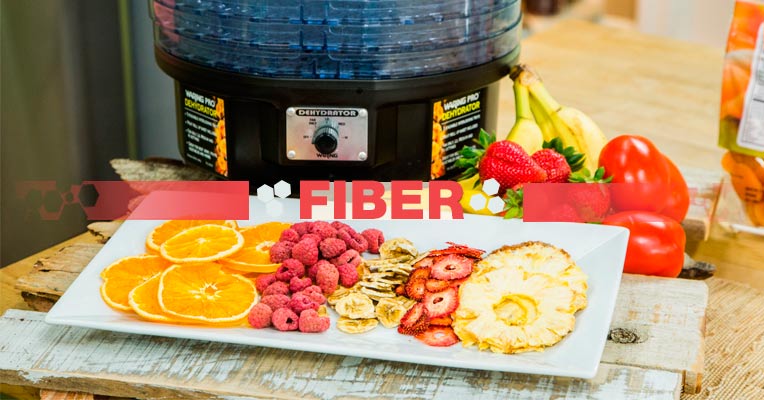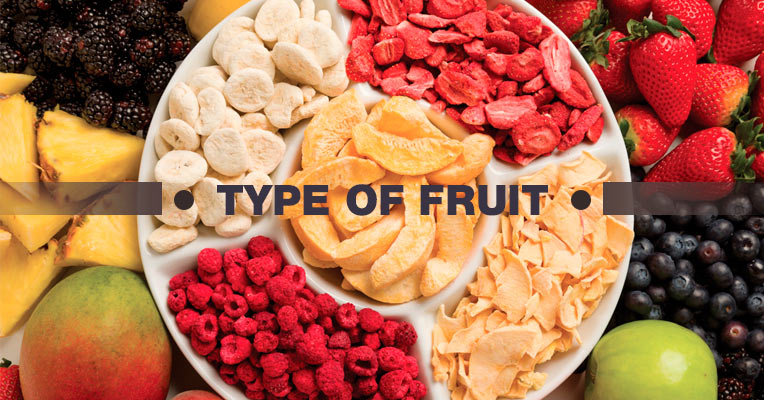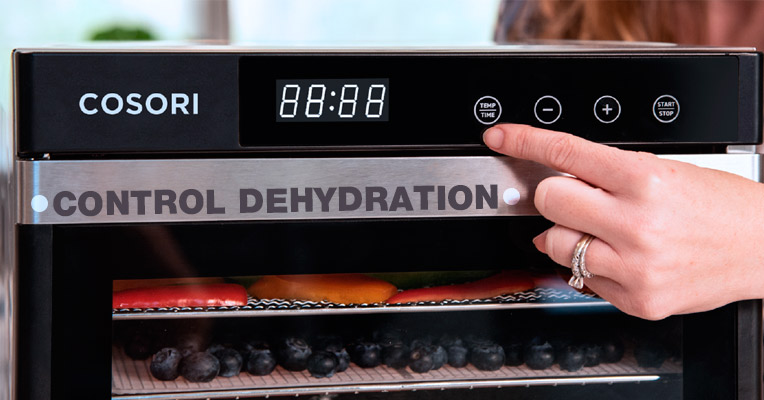Before we get into the nitty-gritty details about drying fruit in a dehydrator, let’s talk about some of the benefits of doing so, as well as which type of fruit is best to dehydrate. Those who are new to the process will be able to see the benefits of doing so, as well as learn beforehand which types of fruit can be best dried for future use.
In short, dried fruit is any type of fruit that has had the majority of its water content removed from it. As a large amount of most fruit consists of water, this inevitably results in the fruit losing most of its hydrated mass, leaving the dried fruit portions being much smaller than the fully hydrated fruit. Removing the water content, however, doesn’t remove the benefits that fruit often provide to the human body. In fact, these beneficial parts of the fruit are often left behind, resulting in portions that contain high proportions of vitamins and minerals that the body needs. This actually results in many dried fruit being labeled as “superfoods”, which are defined as being foods that are extremely rich in nutrients, having a much higher portion of beneficial content than most others.
Another benefit of dried fruit is in how it affects the body’s blood sugar level. Dried fruit tends to have what is called a low Glycemic Index, which is used to rate how different types of foods affect the body’s blood sugar level. In short, a low to medium Glycemic Index in any type of food means that the body doesn’t have to replace its own insulin production with the sugar provided from the food, thus allowing the body to retain normal blood sugar levels even when large amounts are eaten. Of course, the actual Glycemic Index will vary between the different types of dried fruit, but even the ones with the highest remain safe to eat.
One other benefit of dried fruit, and one that many people tend to be the most aware of, is in its high fiber content. Fiber is a natural compound that is often present in most plant-based foods that the body can’t fully digest, which results in it passing through the body in a method that cleans a person’s digestive system. It also has the added benefit of removing cholesterol and other harmful elements from the body.
One of the simple facts about drying fruit that one should be aware of is that some types of fruit dry better than others. Typically, those with the lowest proportion of water to solid material will dry better (as in retaining more of their mass) than those with a much higher proportion of water content. Having said that, even those with an extremely high amount of water content (such as oranges) can be dried, leaving behind solid material that is rich in nutrients. In fact, some of the most popular types of fruit to dry, including plums and grapes, have a high proportion of water content.
Speaking of grapes, there is hardly a person who has never eaten a raisin before, and even then, there are few people who don’t enjoy eating them. Another example of a very popular type of dried fruit is prunes, which are essentially dried plums, and are known for their extremely high fiber content. Other types of dried fruit which are extremely popular are apricots, figs, peaches, and dates. Even some other types of fruit which aren’t often found in dried form, such as apples and oranges, can prove to be a popular treat, retaining much of their flavor and nutrients. In short, virtually any type of fruit can be dried.
There are quite a few different methods of dehydrating fruit, including leaving out in the sun, heating through other means, or even freeze drying, but the most convenient way to dehydrate food for the normal kitchen would be through using one of many different models of food dehydrators. These devices are kitchen appliances that are used specifically for dehydrating many different types of food, including fruit, in a safe and simple way that helps to retain all of the nutritional benefits of the food. Most food dehydrators use the process of evaporation in order to remove the water content from food, and then, in turn, remove the condensation from the food area, providing a quick and effective method of dehydration that keeps the food in top condition.
Since most food dehydrators use a similar dehydration process, these appliances tend to often look and operate similar to each other, which means that learning how to use one should translate well to learning how to use any model of the many food dehydrators that are on the market. This, in turn, makes it easy to provide instructions for basic fruit dehydration that can be followed on almost any type of food dehydrator. Below are some basic steps that you can follow to dehydrate almost any type of fruit in whichever dehydrator you use.
Just as not all fruit is the same, the preparation of different types of fruit will also vary. For instance, if you are trying to make raisins out of grapes, there is little that you need to do to prepare the grape, outside of removing the seed if it isn’t seedless. On the other hand, larger fruit such as pears or apricots simply can’t be wholly dehydrated without some type of preparatory work, which will involve slicing the fruit into thin slices no more than several millimeters thick. In general, fruit with a lower overall water content should be cut into thinner slices than those with a higher content, as the thinner slices will allow for better thorough dehydration. In general, though, the most important thing is to make sure that the fruit slices are thin enough to fit on the multiple trays that are provided in any food dehydrator.
As most food dehydrators use heat for dehydration, most food dehydrators will have adjustable heat settings that will range somewhere between 90 F to 160 F. The actual range of any given food dehydrator may vary from this, but typical fruit dehydration temperatures should easily fit within this range. As such, the amount of time it takes to dehydrate fruit can vary, depending on the temperature setting used. One thing to keep in mind, though, is that although higher temperature settings will dehydrate fruit faster, the fruit will also tend to lose more of its nutritional benefits with a higher setting. In the end, it is usually best to dehydrate fruit at the lowest temperature possible.
Once the fruit has been prepared, you can place the fruit slices on each tray of the food dehydrator. It is best to place the slices evenly without any overlap in order to allow the dehydration process to go unhindered. Once this is done, close the door of the appliance and turn it on. The best temperature setting that can be used for most fruit is between 110 F to 115 F, which in general will take about 5 to 6 hours for fruit to be fully dehydrated. This time, of course, will vary depending on the thickness of the fruit slices as well as the type of fruit that is being dehydrated. As most food dehydrators will have clear doors that allow you to see the contents, it is best to check the fruit to make sure it is fully dehydrated before removing.
Once your fruit has been fully dehydrated, it is best to place it in some kind of sealed container immediately after removal from the food dehydrator, so as not to allow it to reabsorb moisture. Once the fruit has been placed in a sealed container, you can store it at room temperature, which will give the best results in regard to its flavor and nutrient content. Storing at room temperature should allow the dried fruit to remain good for up to a year, provided that it remains in a sealed container. Although refrigeration and even freezing can let you store dried fruit for much longer periods of time, it will tend to lose its taste and nutrients over time, even when frozen. In addition, frozen dried fruit can be susceptible to freezer burn.
If the benefits of dehydrated fruit, as well as the ease with which fruit can be dehydrated all, seem appealing to you, then you are probably wondering which food dehydrator is the best one on the market. Although the wide variety of food dehydrators tend to have a very similar feature set that is shared between them, there is one model that tends to stand out from among all of the others. The Cosori Premium Stainless Steel Food Dehydrator gives you the right mix of the best features of all food dehydrators along with an extremely durable build that lets you easily dehydrate fruit while retaining its flavor and nutrient-rich content. Below are some of the advantages that you get with this food dehydrator.
This food dehydrator from Cosori gives you the top-end specs that anyone would want in such an appliance, along with features that make it both extremely effective and easy to use. This 600 W model is powerful enough to dehydrate food at temperatures ranging from 95 F to 165 F, making it suitable for any fruits as well as most other types of foods, with dehydration times ranging anywhere from 30 minutes to 48 hours. The unit comes with 6 stainless steel drying racks as well as a mesh screen and fruit roll sheet, which are all extremely easy to clean after use thanks to being fully dishwasher safe. There is even overheating protection and automatic shutoff features that make the unit extremely safe to use.
Thanks to the easy controls as well as the clear glass door, you can dehydrate your food with this appliance to the exact level that you wish. The controls can be set in just a few seconds, and the clear glass door lets you watch the dehydration process from start to finish, giving you a clear view of the fruit being dehydrated as well as letting you stop the process at any time in order to prevent it from becoming overheated.
Your new food dehydrator from Cosori gives you the best tasting dried fruit, retaining all of its flavor and nutrition while allowing you to store it easily for long periods of time. What’s more, though, is that with the Christmas season fast approaching, you can even create some tasty Christmas ornaments for your Christmas tree with dried fruit. This gives you a cheap and easy way to decorate your house for the holiday season!
Some of the best fruits for being used as ornaments are listed below:
- Cranberries (threaded together as garland)
- Grapes (raisins, threaded together as garland)
- Apples
- Pears
- Oranges
- Lemons
- Apricot
- Kiwi
For ornaments that are not used as garland, these are best made when each type of fruit is sliced horizontally, leaving the core or seed grouping of the fruit in the center of the slice, and then dehydrated for the appropriate amount of time in your Cosori Food Dehydrator. Just be careful not to overheat them, as you want them to retain as much of their original color as possible. You can even use food coloring or paint to enhance the color of the dried slices if you so desire, making very easy and cheap Christmas tree ornaments that are safe for the whole family!
Conclusion
Being armed with your newfound knowledge of the best fruit dehydrator as well as the best ways to create some tasty and nutritious snacks, it should be obvious to anyone what advantages that having the Cosori Premium Stainless Steel Dehydrator can bring to your home. Whether you want to dehydrate fruit for long term storage, or even create some tasty and festive ornaments, this appliance will quickly become one of your favorite kitchen companions. If you don’t have one already, help spice up your kitchen for the holidays and beyond by ordering this food dehydrator.











